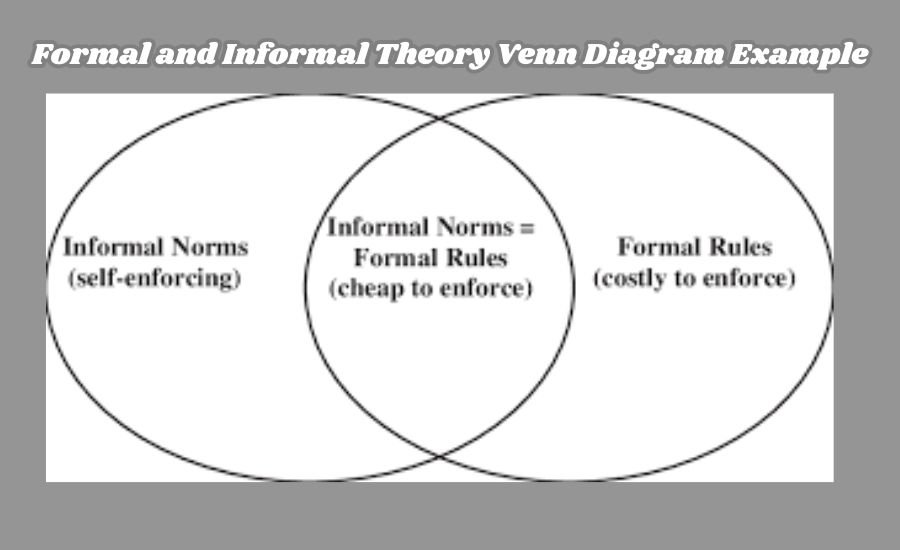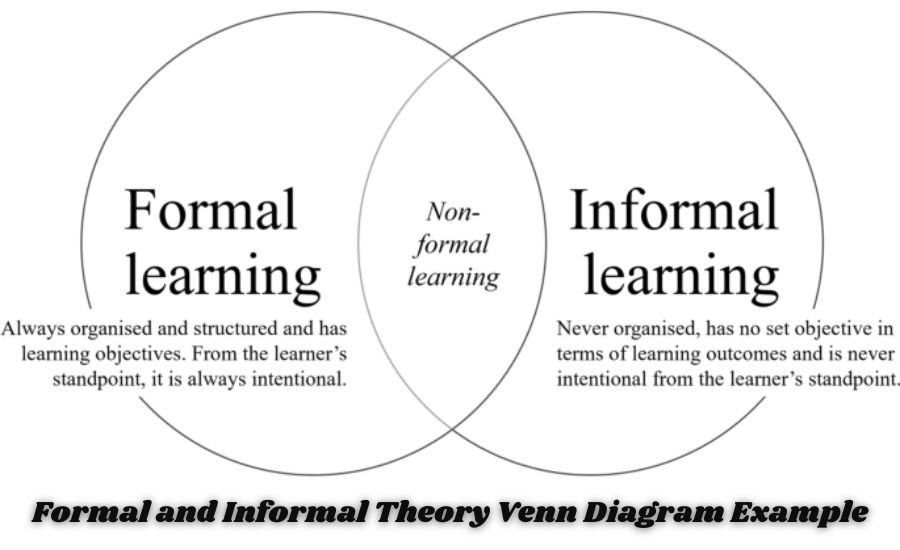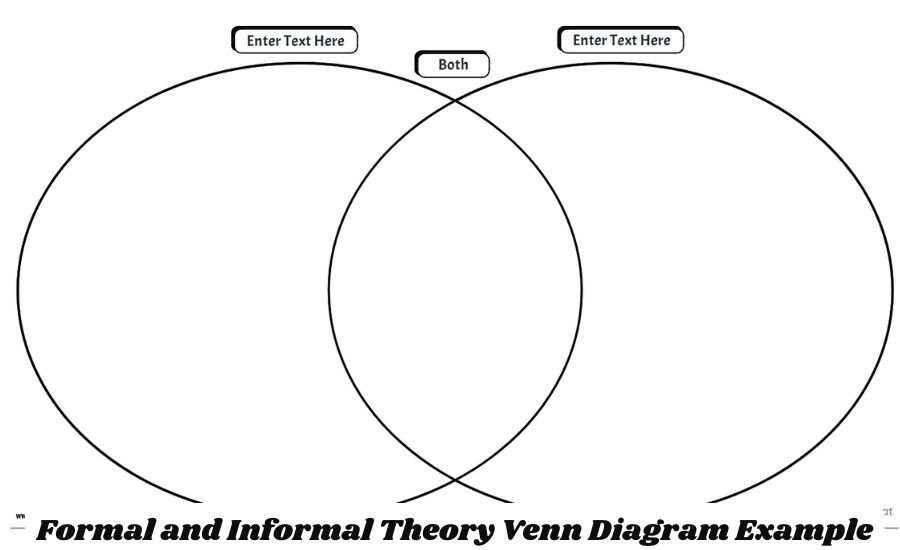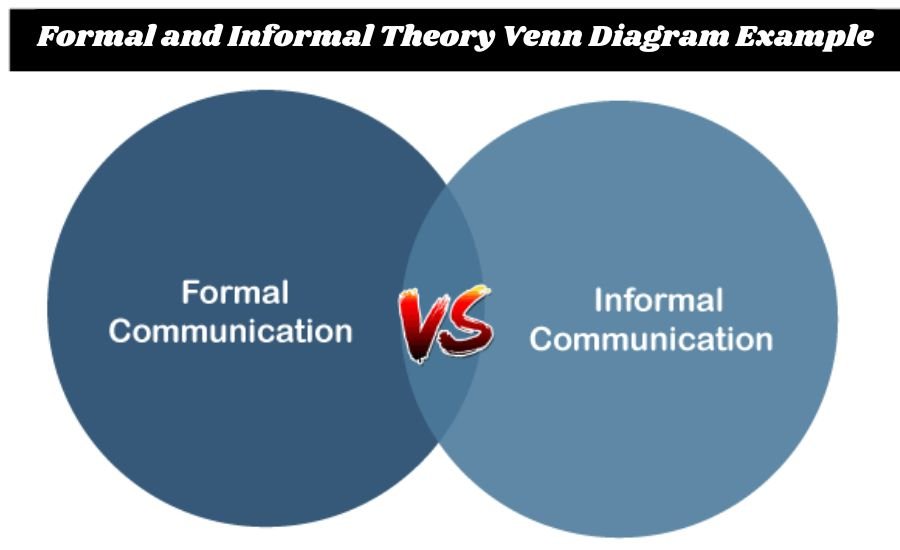Formal and informal theory Venn diagram examples help us see how different ideas connect and overlap. If you’re curious about how these theories work together, you’re in the right place! Here at VistaGlimpse, we’ll make it easy for you to understand the critical concepts behind formal and informal theories using Venn diagrams as our guide.
In this blog, we’ll explore the basics of both formal and informal theories, showing their differences and similarities through clear formal and informal theory venn diagram example. Whether you’re a student or just love learning new things, this guide will make complex ideas accessible and fun!
What is a Venn Diagram? Basics for Beginners
A Venn diagram is a simple and fun way to show how different ideas or things connect. It’s like drawing circles that overlap to show what two or more things have in common. formal and informal theory venn diagram example are often used in school to help students easily see connections between ideas. You might see them in math, science, and stories to compare characters or events.
In a Venn diagram, each circle represents a different item or idea. When two circles overlap, the items in those circles share something similar. This overlapping area is where the magic happens – it helps us understand similarities and differences clearly. The more circles there are, the more comparisons we can make. This is especially useful when exploring theories or concepts like formal and informal theories.
Venn diagrams are beneficial for visual learners. Sometimes, seeing information in a picture makes remembering easier than reading a long description. You’re turning a big idea into a small, easy-to-understand one. You’re using a Venn diagram to explain something complicated. That’s why they’re popular tools in classrooms and why we use them to explain concepts like the formal and informal theory of the Venn diagram example.
Understanding Formal and Informal Theories in Simple Terms
Formal and informal theory venn diagram example are ideas that help explain how things work, but they approach this in different ways. Formal theory is more structured and follows strict rules, while informal theory is more flexible and based on everyday experiences. This makes them both valuable in understanding the world but serve different purposes.
Formal theories are instructions you follow step-by-step, with clear guidelines to reach a specific outcome. Think of them as recipes where each ingredient and instruction needs to be precise. Because they require exactness, formal theories are often used in science and math. These theories help us make predictions or understand processes reliably.
On the other hand, informal theories don’t have strict rules. They are based on observations or common sense, which means they can change over time. For example, suppose you observe that animals move toward water. In that case, you might create an informal theory about animal behavior near water sources. Informal theories are helpful for everyday situations and can explain things that don’t need strict rules.
Why Use Venn Diagrams? Benefits of Visual Learning
Venn diagrams are excellent visual learning tools, meaning understanding things better by seeing them. When we look at pictures or diagrams, it often makes things easier to remember and understand. A formal and informal theory venn diagram example is a simple way to compare and contrast different ideas, like formal and informal theories, in a clear and organized way.
One of the main benefits of Venn diagrams is that they make complicated ideas look simple. By placing ideas in circles and showing how they overlap, Venn diagrams give us a quick overview of what’s similar and different. Teachers often use them in subjects like science, math, and even language arts to help students grasp new concepts faster.
Another great thing about formal and informal theory venn diagram example is that they are flexible. You can use as many circles as you need, depending on how many items you want to compare. A basic two-circle Venn diagram works well for formal and informal theories, showing what each theory uniquely offers and where they connect. This is particularly useful when studying theories that need to be clarified first.
Using a Venn diagram for topics like the formal and informal theory Venn diagram example can make learning more interactive and engaging. When students create their own Venn diagrams, they get hands-on experience, which often helps them remember the information better.
Must Know: 119 Angel Number
Formal Theory Explained with Easy Examples
Formal theory is a way of understanding things using exact rules and facts. Think of formal theory as a set of instructions or rules that tell you how something should work, and it doesdoesn’tnge from person to person. This is important in fields like science and math, where we need reliable results that can be repeated by anyone who follows the same rules.
For example, formal we’reies can help us understand the steps needed to solve an equation in math. Once we know the theory, we can apply it repeatedly and expect the same answer. Formal theories are also common in law or coding, where therethere’sear stratstthere’sato specific outcome.
Because formal theories must be precise, they are often written in specific, technical language. But don’t worry—thesdon’tories cannot be simplicddon’tworryanstood with practice. A formal and informal theory venn diagram example can be a helpful tool here, allowing us to place formal theories alongside informal ones and see how they differ.
In a formal and informal theory Venn diagram example, formal theories would be in one circle with strict rules, while informal theories would be in another, showing more flexible guidelines. By using a Venn diagram, we can clearly see how formal theories rely on structure and predictability.
What is Informal Theory? Simple Ideas for Easy Learning

Informal theory is a set of ideas we create based on observations and experiences. Unlike formal theories, informal theories ddon’thave strictddon’thddon’thavemstrictddon’thaveeyan change as we learn new things. This type of theory is often used in everyday situations where things aren’t precise and unpredictable. An excellent formal and informal theory venn diagram example of an informal theory is how we predict the weather. Suppose you notice that dark clouds usually bring rain. In that case,. In that case, you might think, “” when there are d,””k cl,” or” ds, it will rain “””” This informal t”” ory”” based on what you’ve observed, such as observed observed helps us make sense of things around us without needing exact instructions.
Because informal theories are based on common sense, they can differ from person to person. What one person thinks is true might not be the same for another, so informal theories are flexible. They can be adjusted as we gain more experience and learn from others.
In a formal and informal theory Venn diagram example, informal theories might appear in a separate circle, showing flexibility and adaptability. This makes it easier to compare them with formal theories, which stick to strict rules, helping us understand when each type of theory is most beneficial.
Creating a Formal and Informal Theory Venn Diagram Example
Creating a formal and informal theory venn diagram example to compare formal and informal theories is easy and fun! You start by drawing two circles that overlap slightly. Each circle will represent one type of theory – one for formal theories and the other for informal theories. The overlapping part in the middle shows what both theories share, like common goals or ideas.
In the circle for formal theories, you can list their strict rules, clear structure, and reliance on facts. Formal theories do change. These are often used in areas like science and law, where following exact steps is essential.
In the circle for informal theories, write down their flexibility, adaptability, and connection to everyday experiences. Informal theories strand areas based on onaaren’tashangeon or observations. These are common in social situations, where things do always
follow the formal and informal theory venn diagram example; you can see how formal and informal theories differ and where they overlap. This helps us understand when to use each type of theory, depending on the situation. This visual tool makes learning about complex ideas like the formal and informal theory of the formal and informal theory venn diagram example.
Critical Differences Between Formal and Informal Theories
Formal and informal theories might help us understand the world, but their work is pretty different. The main difference is that formal theories are strict and follow clear rules. In contrast, informal theories are more flexible and based on everyday life experiences.
For example, formal theories need evidence and proven facts to back them up. This makes them reliable and consistent. They’reused, mafTThey’reusedcienceaccuracy is critical. When something follows a formal theory, we can expect it to work similarly if we follow the same steps.
How Formal and Informal Theories Overlap: Venn Diagram Insights
While formal and informal theories are different, they share some similarities, which can be shown in the overlapping area of a formal and informal theory formal and informal theory venn diagram example. Both types of theories aim to explain how things work or why things happen. They help us understand the world but approach it in their own ways.
Formal and informal theories are tools we use to make sense of situations, even if they have different rules. They guide our understanding and help us make strict or flexible decisions. For example, both theories can be used in education. Teachers may use formal theories for math and informal theories for discussions or debates.
Another overlap is that both types of theories rely on reasoning. Formal theories use scientific reasoning, while informal theories rely on common sense or personal experience. This means that, despite being different, both theories require us to think critically and analyze what we know.
A formal and informal theory Venn diagram example highlights these shared qualities. By looking at how they overlap, we see that both types of theories are essential for learning and understanding in different ways. This insight helps us appreciate the role of each theory in everyday life and education.
Examples of Formal Theory in Everyday Life

Formal theories might sound complex, but tthey’repart of otthey’tthey’repart Forotthey’repartlivesbout the rules in math. When we add numbers, we know exactly what to expect. This is an example of formal theory because it follows strict rules and gives the same answer each time.
Another example of formal theory is in cooking recipes. A recipe tells precisely how much of each ingredient to use and what steps to follow. If you follow the recipe, yyou’llalways getyyou’lyyou’llalwayssgetyyou’llalwayshtructions is like a formal theory, showing that we get a predictable result if we follow the rules.
In law, formal theories are used all the time. Laws are written with specific language so people know precisely what is allowed and iisn’t When everyiisn’tiisn’tthe laeveryiisn’tllowssmoothly. This shows how formal theories help keep order and ensure fairness.
In a formal and informal theory Venn diagram example, these practical examples of formal theories would fit perfectly under the formal theory circle. These examples show that formal theories are reliable and consistent, making them useful daily.
Real-Life Examples of Informal Theory and How They Work
Informal theories are all around us and come from our observations and experiences. For instance, you might notice that if you smile at someone, tthey’relikely totthey’tthey’relikelystotthey’relikelyhistiisn’ta, but thatiisn’tait often. This is an informal theory based on how people usually react.
Another example of an informal theory is guessing the weather. If you see dark clouds, you might think it will rain. TThere’snoystrictTThere’snoells you that dark clouds often mean rain. Informal theories like these help us make quick decisions based on our learning.
In schools, teachers might use informal theories to manage classrooms. They know from experience that specific approaches work better with students. These methods aaren’twritten ruaaren’aaren’twrittenaruaaren’twrittenreatenment. This is how informal theories are applied in social settings.
In a formal and informal theory Venn diagram example, these real-life applications of informal theory would be in the circle for informal theories. These examples show that while informal theories aaren’texact, tthaaren’aaren’texacty’tthaaren’texacteltthey’restillrstandinghe world around us.
Formal vs. Informal Theory: Using a Venn Diagram for Clarity
Understanding the differences between formal and informal theories can be tricky, but using a Venn diagram makes it more transparent. A formal and informal theory formal and informal theory venn diagram example helps us visualize how these two theories compare and contrast. By drawing two overlapping circles, we can easily see what makes each theory unique and where they connect.
In the circle for formal theories, we can list important characteristics like precision, structure, and rules. These traits help us see that formal theories provide reliable information, especially in scientific and mathematical contexts. They are the backbone of many fields that rely on exact outcomes.
Conversely, the circle for informal theories showcases flexibility, adaptability, and personal experiences. Informal theories help us understand everyday situations where strict rules ddon’tapply. Thisddon’tddon’tapplyorThisddon’tapplyowbe helpful in social contexts where things are less predictable.
The overlapping section in the Venn diagram illustrates how both theories help us learn and understand the world. They both aim to explain why things happen, making them valuable in their own ways. A formal and informal theory Venn diagram example helps us grasp these concepts, enhancing our overall understanding.
How to Make Your Own Formal and Informal Theory Venn Diagram
Creating your own formal and informal theory formal and informal theory venn diagram example is a fun and educational activity! To start, yyou’llneed some yyou’lyyou’llneedl or myyou’llneedst, draw two large circles that overlap in the middle. One circle will be for formal theories and the other for informal theories.
For the informal theories circle, you can add characteristics such as “”lexible,””””ase””on o””er”” “””” “” ,”””” d “”dapt”” “”” The” “”des””ipti”” s “”ghlig “” the natu”” of informal theories, showing how they differ from formal theories. Thinking It’sabout real-liIt’sabIt’saboutyreal-liIt’saboutesagram is essential, as it can help make the information more relatable and easier to understand.
Once yyou’vefilled in yyou’vyyou’vefilleda moyyou’vefilledat the overlapping section. Here, you can jot down similarities, like how both theories help us explain the world. Making your own formal and informal theory Venn diagram example is a great way to reinforce what yyou’velearned anyyou’vyyou’velearnedeanyyou’velearnedeese essential concepts.
Exploring the Importance of Theory in Education and Beyond

Theories play a crucial role in education and many other fields. They help us understand complex ideas and provide frameworks for learning. Formal and informal theories explain subjects like science, math, and social studies in schools. They give students the tools to think critically and analyze the world around them.
In education, formal theories guide teaching methods. Teachers use proven techniques to deliver lessons effectively. These methods are based on research and evidence, ensuring students receive reliable information. This structure is essential for creating a solid educational foundation.
A formal and informal theory Venn diagram example shows how both theories contribute to education. While formal theories provide structure, informal theories encourage creativity and adaptability. Together, they create a balanced approach to learning that helps students thrive in and out of the classroom.
Formal and Informal Theory Venn Diagram Example: Step-by-Step Guide
Making a formal and informal theory formal and informal theory formal and informal theory venn diagram example is a straightforward process that can enhance your understanding. To start, gather your materials, such as paper and colored pens or pencils. Begin by drawing two large circles that overlap in the center. Label one circle “”ormal Theory”””” th”” ther “”” for” al Theory.””Next, think abo”” th”” critical charac”” stics of formal theories. Write these traits in the formal theory circle. Consider traits like “”tructured,””“”a”” d o”” facts” “”” “”” “”eliable.”””” s “”ll “”lp “” u recogniz””the str””ths of formal theories in different areas.
Then, turn to the informal theory circle. Here, you can list traits like “”lexible,””“”ase””on p””so”” “””” “” eri”” ces,””an” “””ject to”” han”” “””T””s helps h “””” g””” “he nature of in””rmal theories and how they work in everyday situations.
In the overlapping section, write down similarities, such as “”oth aim to expl””n th””world””and “”ot” “help “” ma”” “dec””ions.””Th”” imp”” pro”” ss “” ves you a clear””isual representation of how formal and informal theories compare. Using a formal and informal theory Venn diagram example, you can quickly see how both theories work together in our understanding of the world.
Why Understanding Theory Differences Matters for Students
Understanding the differences between formal and informal theories is essential for students. It helps them become better thinkers and learners. When students recognize that there are different ways to explain and understand concepts, they become more open-minded and adaptable.
Students learn to follow rules and methods in math and science by learning about formal theories. This understanding is essential for solving problems accurately. It prepares them for real-world situations where following a structured approach is necessary.
On the other hand, understanding informal theories allows students to think creatively and draw from their experiences. This is especially valuable in social studies and language arts, where personal insights can lead to deeper understanding. Informal theories encourage students to express their ideas and learn from one another.
Students can visually see how these theories connect and differ in a formal and informal theory Venn diagram example. This understanding enhances their education and prepares them for life outside the classroom. By appreciating both theories, students become well-rounded thinkers who can approach problems from multiple angles.
Conclusion
In conclusion, understanding formal and informal theories is essential for everyone, especially students. By learning about these two types of theories, we can see how they help us make sense of the world around us. Using formal and informal theory venn diagram example makes comparing and contrasting these ideas easy, showing us what makes each theory unique and how they work together.
We can become better thinkers and learners by exploring formal and informal theory examples. This knowledge helps us in school and in our everyday lives. Remember, whether fit’sollowing strfit’sofit’sollowingnstrfit’sollowingadaptingth theories are valuable. Keep exploring, asking questions, and using formal and informal theory formal and informal theory venn diagram example to make learning fun and easy!
Must-Have Information: nvm 走镜像源
FAQs About Formal and informal theory venn diagram example
Q: What is a Venn diagram?
A: A formal and informal theory venn diagram example is a visual tool that uses overlapping circles to show how different ideas or items relate to each other. It helps us compare and contrast the similarities and differences between them.
Q: What are formal theories?
A: Formal theories are structured ideas that follow strict rules and methods. They rely on proven facts and are often used in fields like science, math, and law to provide reliable information.
Q: What are informal theories?
A: Informal theories are flexible ideas based on personal observations and experiences. They ddon’tfollow striddon’tddon’tfollowhstriddon’tfollow more about a situation.
Q: How can a Venn diagram help in education?
A: A Venn diagram helps students visualize and understand complex ideas by showing how different concepts compare and overlap, making learning more interactive and engaging.
Q: Why is it important to understand both formal and informal theories?
A: Understanding both types of theories allows students to think critically and adapt their learning strategies, helping them approach problems from different angles in various subjects.
Q: How do I create my own Venn diagram?
A: To create a Venn diagram, draw two overlapping circles on paper. Label each circle with a different idea, and fill in their unique traits and similarities in the overlapping area.
Q: Can Venn diagrams be used in subjects other than math?
A: Yes! Venn diagrams can be used in many subjects, including science, language arts, and social studies, to compare characters, events, theories, and more.
Q: What is the purpose of using a formal and informal theory Venn diagram example?
A: Using a formal and informal theory Venn diagram example helps us visually see the differences and similarities between the two types of theories, making complex ideas easier to understand.
